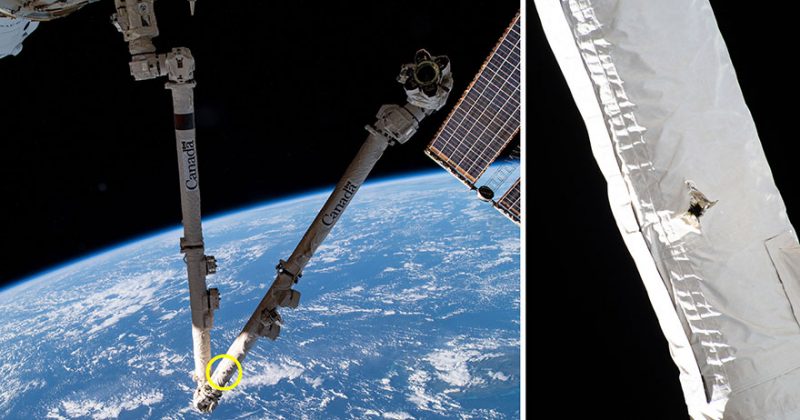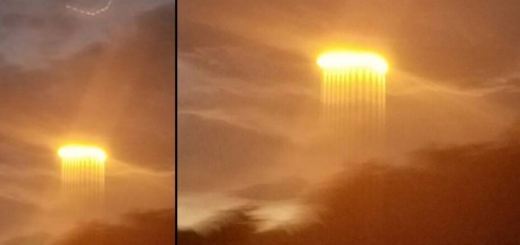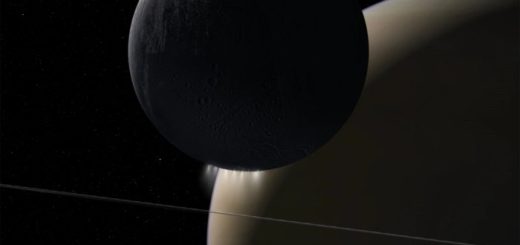Lucky Strike: Space Debris Smacked ISS Robotic Arm

Lucky strike
The Canadian Space Agency (CSA) confirmed on May 28, 2021 that a piece of space debris smacked into the robotic arm on the International Space Station (ISS), creating a noticeable hole in the arm. CSA provided the arm – called Canadarm2 – to ISS. It’s been in service in orbit since 2001. A routine inspection on May 12 revealed the hole, CSA said, adding that near-term operations “should not be affected.”
CSA called the hole a “lucky strike,” given the relatively small size of the arm, which is 57.7 feet (17.6 meters) long but with a diameter of only 14 inches (35 cm). CSA said:
While the utmost precautions are taken to reduce the potential for collisions with the ISS, impacts with tiny objects do occur …
Experts from the Canadian Space Agency (CSA) and NASA worked together to take detailed images of the area and assess the impact, which occurred on one of Canadarm2’s boom segments.
Despite the impact, results of the ongoing analysis indicate that the arm’s performance remains unaffected. The damage is limited to a small section of the arm boom and thermal blanket. Canadarm2 is continuing to conduct its planned operations, including hoisting Dextre [the space robot] into position to replace a faulty power switchbox (Remote Power Control Module).
NASA and the CSA will continue to gather data to conclude the analysis. Near-term robotics operations will continue as planned.
According to Space.com:
Canadarm2 was scheduled soon to move a Canadian robotic hand, Dextre, into a spot to replace a faulty power switchbox called the Remote Power Control module, but CSA added that operation should not be affected whatsoever. Both Canadarm2 and Dextre are usually operated from CSA headquarters near Montreal, Quebec.
The U.S. Space Surveillance Network does 24-hour surveillance of more than 23,000 objects the size of a softball or larger in Earth-orbit. The goal is to prevent potential collisions with satellites and ISS. In addition, there are untold numbers of smaller objects in Earth-orbit —ranging from rock-sized to dust-sized – too small to be monitored.
Space agencies take the threat of collisions with space debris seriously. NASA has a long-standing set of guidelines to ensure the safety of ISS crew. For example, in September 2020 – in an abundance of caution – a three-person ISS crew were ordered to shelter near an escape vehicle, while flight controllers worked to reboost the station to a higher orbit. The reboost was to avoid what NASA called a “possible conjunction” with an unknown piece of space debris, which, ultimately, did not strike the station. Read more about the September event.
Bottom line: A piece of space debris smacked into the robotic arm on the International Space Station (ISS), creating a noticeable hole in the arm. Near-term operations “should not be affected.”



 Creators of mankind
Creators of mankind Description of “Tall white aliens”
Description of “Tall white aliens” Where they came from?
Where they came from? About hostile civilizations
About hostile civilizations The war for the Earth
The war for the Earth “Tall white aliens” about eternal life
“Tall white aliens” about eternal life Video: “Nordic aliens”
Video: “Nordic aliens” Aliens
Aliens Alien encounters
Alien encounters The aliens base
The aliens base UFO
UFO Technology UFO
Technology UFO Underground civilization
Underground civilization Ancient alien artifacts
Ancient alien artifacts Military and UFO
Military and UFO Mysteries and hypotheses
Mysteries and hypotheses Scientific facts
Scientific facts


















